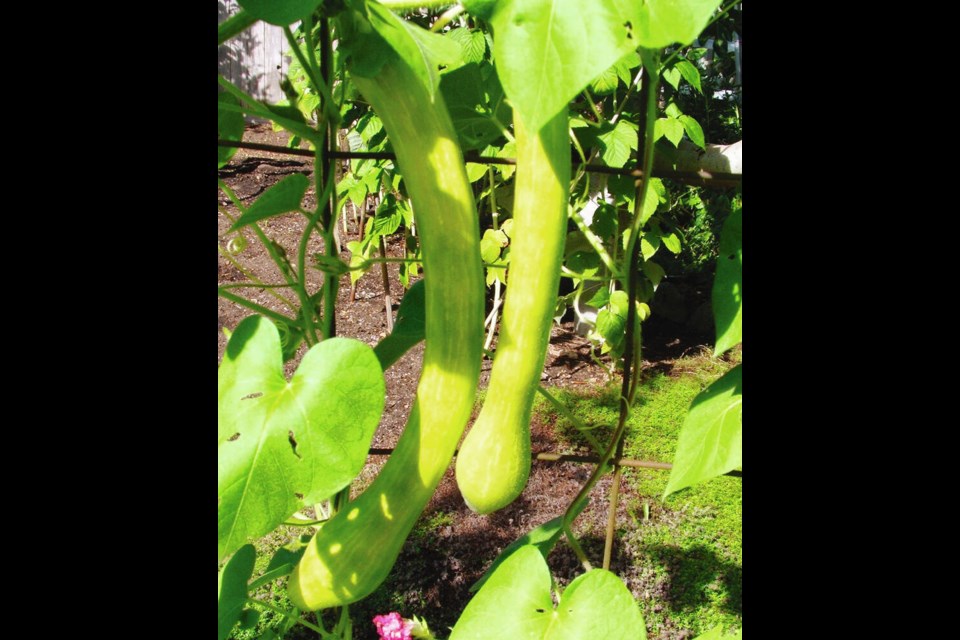Finding specific seed varieties has been a hit-and-miss affair again this year. Many times I’ve found a listing for a particular seed, only to find it marked “unavailable” or “out of stock.”
When the usual sources for plant “regulars” dry up, a search for an alternate supplier begins.
Almost every year I grow a climbing Italian zucchini called Tromboncino for its long, trombone-like shape. The vines produce slender, lime green fruits with a bulbous blossom end that holds all the seeds.
As I looked for an alternate source for seeds, I found my summer squash on the attractive and easily navigated Renee’s Garden website as Trombetta di Albenga, described as an heirloom with “a curvaceous trumpet shape and a delicate mild taste with a hint of nutty artichoke flavour.”
Other sources can be found by typing “Climbing Italian zucchini seed source” into a search engine.
The other seeds that my usual source no longer offered were for an alpine strawberry called Mignonette. It too was listed on the Renee’s Garden site, with the herbs, where it is described as “A French delicacy” featuring “compact perennial plants that grow in pretty mounds and produce fruits the first summer from seed.”
Mignonette is a selection of Fragaria vesca, the “wood strawberry” — a species widespread in British Columbia. The little plants are attractive along sunny plot edges, where the small, pointed berries are handy for plucking.
Strawberries and more. A second seed search was inspired by a reader’s email following a column with my suggestions for low-growing, tight-knit ground covers. “I read your groundcover recommendations, hoping you would mention our local native strawberries. Alas, you did not.
“So far I’ve tried two of our native strawberries, although I’ve been growing only one species long enough to have achieved a groundcover with it. It’s our coastal strawberry (Fragaria chiloensis) and it’s really beautiful, with glossy green leaves and red stems. The flowers are pretty, but it’s the leaves that make it so beautiful.
“Native strawberries are also extremely beneficial because they support a high number of caterpillar species. When choosing a ground cover, why not choose ones that will support insects, and in turn birds?”
Thanks to Ann Tiplady for this interesting and useful information. It sent me on a seed search for coastal strawberry, which is also called beach strawberry and Chilean strawberry.
According to the Garry Oak Ecosystems Recovery Team, coastal strawberry is an ornamental ground cover that provides food for birds and the flowers are a nectar source for butterflies. The plants’ extensive root systems are useful in sand dune binding.
Scurrying around the internet looking for a seed source, I came upon one entirely new to me — Twining Vine Garden in Fanny Bay. They list seeds for trees and shrubs including many rhododendron species, and for perennials, vegetables, herbs, and flowers. Their F. chiloensis seeds were “collected from the coastal beaches of Haida Gwaii.” They describe the fruit as succulent and “incredibly fragrant,” the plants easy to grow.
I added to my order Blue Beauty, a glossy tomato with deep blue-black shoulders and a dark red body, and Clematis heracleifolia (hyacinth flowered clematis), a one-metre tall shrub clematis with late summer, silvery mauve blooms.
But the most surprising and delightful “find” on the site was a small, round, dark-skinned squash called Gem, a variety that had disappeared from my usual sources long ago. It can be used as a summer or winter squash. It’s standard fare in South Africa.
I ordered these seeds online on Jan. 28. They arrived in the mail Feb. 2.
HCP community education. The Horticulture Centre of the 91Ô´´, 505 Quayle Rd. in Saanich, is offering the following workshops. For further details and online registration go to hcp.ca/events. Register online or by phone: 250-479-6162.
* Plant Identification and Culture. The next session of this course will be on Saturday, Feb. 19, 1 to 4 p.m. Jane Tice will introduce 25 new plants with their descriptions, cultural requirements, general maintenance and landscape uses. This is an ongoing, monthly class. HCP members $40, others $50.
* Pruning Ornamental Plants, Tuesdays, Feb. 22 and March 1, 6:30 to 9 p.m. with a follow-up, hands-on session on Saturday, March 5, 9 a.m. to 12 p.m. Patty Brown will take participants through the theory and techniques of pruning. Members $120, others $145.



